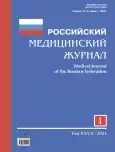Реабилитация больных с диагнозом «детский церебральный паралич» с использованием рефлекторной гимнастики по методу В. Войта
- Авторы: Киселев Д.А.1, Левков В.Ю.2, Губанов В.В.3, Козловский И.В.4, Лайшева О.А.2, Панюков М.В.2
-
Учреждения:
- Дом Здоровья «Воронцовский»
- Российский национальный исследовательский медицинский университет им. Н.И. Пирогова
- Клиника Газмедцентр
- Ханты-Мансийская государственная медицинская академия
- Выпуск: Том 27, № 1 (2021)
- Страницы: 27-32
- Раздел: Клиническая медицина
- URL: https://journals.rcsi.science/0869-2106/article/view/72259
- DOI: https://doi.org/10.17816/0869-2106-2021-27-1-27-32
- ID: 72259
Цитировать
Аннотация
Представлен многолетний опыт использования рефлекторной гимнастики по методу Войта в нескольких медицинских центрах России, что является важной частью освещения данного метода лечебной физкультуры, так как информационной части по предоставлению такого опыта не хватает. Объединение результатов работы коллег из Москвы и городов России дало возможность продемонстрировать преимущества высокоэффективного метода лечения такого тяжелого заболевания, как детский церебральный паралич. Вариабельность и разнообразие технических подходов Войта-терапии в зависимости от тяжести и ортопедических проявлений различных форм заболевания являются несомненным достоинством методики. Войта-терапия не просто работает с двигательной активностью человека, а оказывает выраженное и разнообразное действие на многочисленные акты высшей нервной деятельности. На основе представленного опыта работы с пациентами разного возраста с диагнозом «детский церебральный паралич», можно уверенно говорить о необходимости применения Войта-терапии в комплексном лечении заболевания.
Ключевые слова
Полный текст
Открыть статью на сайте журналаОб авторах
Дмитрий Анатольевич Киселев
Дом Здоровья «Воронцовский»
Email: dmitrydoc@gmail.com
к.м.н.
Россия, МоскваВиталий Юрьевич Левков
Российский национальный исследовательский медицинский университет им. Н.И. Пирогова
Автор, ответственный за переписку.
Email: Levkovv@ya.ru
ORCID iD: 0000-0002-4104-2886
к.м.н., доцент
Россия, 117997, г. Москва, ул. Островитянова, 1Вячеслав Вячеславович Губанов
Клиника Газмедцентр
Email: 270378doc@mail.ru
Россия, Саратов
Илья Вячеславович Козловский
Ханты-Мансийская государственная медицинская академия
Email: info@ra-kurs86.ru
Россия, Ханты-Мансийск
Ольга Арленовна Лайшева
Российский национальный исследовательский медицинский университет им. Н.И. Пирогова
Email: olgalaisheva@mail.ru
д.м.н., профессор
Россия, 117997, г. Москва, ул. Островитянова, 1Максим Валерьевич Панюков
Российский национальный исследовательский медицинский университет им. Н.И. Пирогова
Email: maxim287@mail.ru
к.м.н., доцент
Россия, 117997, г. Москва, ул. Островитянова, 1Список литературы
- Войта-терапия в раннем детском возрасте. Методические рекомендации международного общества Войта-терапевтов. Прага, 1992.
- Киселев Д.А., Левков В.Ю., Губанов В.В., и др. Реабилитация больных с задержкой двигательного развития с использованием рефлекторной гимнастики по методу Войта // Российский медицинский журнал. 2020. Т. 26, № 4. С. 224–227.doi: 10.17816/0869-2106-2020-26-4-224-227
- Войта B., Петерс A. Принцип Войты. Игра мышц при рефлекторном поступательном движении и в двигательном онтогенезе. 2014.
- Vojta V, Schweizer-Völker E. Die Entdeckung der idealen Motorik. Die Entwicklung der angeborenen Bewegungsmuster im ersten Lebensjahr: Kinesiologische und muskuläre Analyse. 2009.
- Войта В., Петерс А. Принцип Войты. 2015.
- Vojta.com [интернет]. Сайт Международного сообщества им. В. Войта [дата обращения: 10.02.2012]. Доступ по ссылке:https://www.vojta.com.
- Thiesen-Hutte M. Psychologie und Neurophysiotherapie Vojtas. Stutgart: Enke Ferdinand, 1992.









